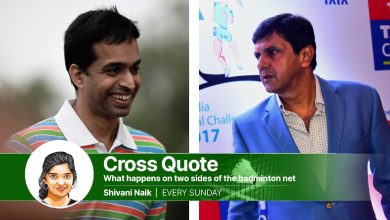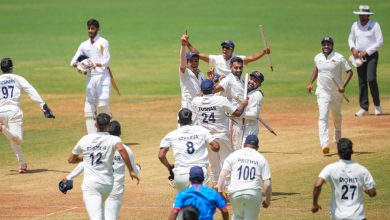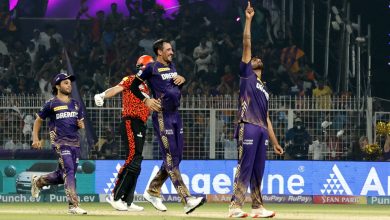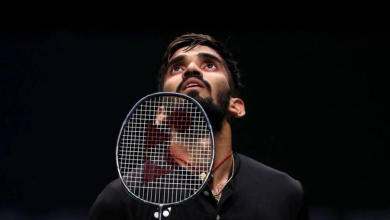India vs Sri Lanka: Teardrop island’s sob story

Dinesh Chandimal stood beside the ropes staring vacantly as Virat Kohli and his colleagues celebrated feverishly having won the Test series. The Sri Lankan captain smiled when cameras panned towards him, but it was clearly a forced smile. Just four Tests into his new role, it seemed he was already feeling the heat.
His is not an unusual plight. Captaining the Sri Lankan team these days is like having a millstone around one’s neck. Or, to use a pop culture reference, it’s the cricketing equivalent of the cursed iron chair of Game of Thrones: no one sits on it comfortably. His predecessor Angelo Mathews too felt the pangs, before he decided to relinquish the uneasy crown. His predecessor, Tillakaratne Dilshan, was reported ousted by Mathews and several other players. Before that, Mahela Jayawardene gave the baton to Kumar Sangakkara, having sworn he would never lead the side after the attack on the team bus in Lahore. Sangakkara, for all his charisma and leadership skills, felt it was getting on his nerves. Rangana Herath was always reluctant.
Captaincy, then, was thrust on Chandimal, the third-most experienced player in the side. This reluctance is strange because Sri Lanka produced one of the finest, and eager, leaders cricket has ever seen: Arjuna Ranatunga. Asked if a Ranatunga was what the Sri Lankan team, in the throes of transition, needed, Sanath Jayasuriya, chairman of the selection committee, said: “Then I’ll be a much relieved and happy man…He’s a once in lifetime leader, so inspirational and charismatic. He comes across as a gruff person, but inside he’s loving and affectionate. But you don’t always get someone like him.”
For much of his reign, the Sri Lankan team was still a ragtag bunch, but still they forged an impression that they couldn’t be easily beaten, or bullied. “When you look at the present team and the team we had in the early 90s, I’d say this team has more talented players, but only that they are taking a lot of time to get adjusted to international cricket. We have to be patient,” Jayasuriya adds.
But as is often the case here, there is no succession plan. On a larger note, here nobody is groomed for anything. Either they do it naturally, or they don’t. “We are learning from our past mistakes and now we are putting in more effort to find players with leadership skills and deputing them with more responsibilities at a younger age. We should also give Chandi a little more time and see if his batting is not affected by captaincy,” he points out. The latter is a more worrying concern and a recurring pattern. Captaincy affected the careers of both Dilshan and Mathews. Naturally, they hope it isn’t the case with Chandimal.
Like Ranatunga, Sri Lanka also need a Dav Whatmore-like coach to mould them into a fighting unit. Of late, this job too has been a bit of a musical chair. The list in the last five years includes Trevor Bayliss, Stuart Law, Rumesh Ratnayake, Geoff Marsh, Graham Ford, Paul Farbrace, Marvan Atapattu, Graham Ford and now Nic Pothas. An irony considering that several Sri Lankan coaches, such as Chandika Hathurusinghe (Bangladesh), have built a steady reputation elsewhere. A stable coach and captain combination could be the first step in resurrecting Sri Lankan cricket.
The first time Aravinda de Silva cast his appreciatory eyes on Mahela Jayawardene was during an inter-school match where he was the guest of honour. He was instantly smitten by the youngster who authored languidly classical cover drives like the man himself. “The amount of time he had and the way he judged the length, I haven’t seen too many youngsters blessed like him. I immediately knew he would become a great batsman,”de Silva says.
He indeed became a great batsman, but not all schoolboy prodigies have gone on to scale Jayawardene-like heights. A couple of classic instances are Jehan Mubarak and Upul Tharanga, whose catalogue of international torment is well-storied. “Of course, it involves a lot of hard work, motivation and sacrifice to translate that potential into international cricket. Only a few in fact have made it into the big stage,” he says.
Yet, school and college cricket are romanticised in Sri Lanka like few other cricket-playing countries in the world. Every match is hyped up like an international match, with the steel bands in tow with subsets of fierce rivalries, like Trinity-Antonian in Kandy, or Royal-Thomian (also called the battle of blues) one in Colombo. The stands will be packed with not only friends and relatives and teachers, but also shrewd scouts from Colombo. After the match, deals are brokered.
De Silva snaps into a reverie. “The atmosphere used to be electric with a lot of fun in the stands, and sometimes even fights between fans of opposite sides. But in the end, it was a great day of enjoyment. That’s the foundation of Sri Lankan cricket, and that’s how we have all come through,” he says.
However, the school-college cricket culture is mostly an urban phenomenon, constricted to a handful of cities like Colombo, Kandy and Galle and its suburbs, a reason almost every other cricketer to have represented Sri Lankan are from the three pockets. And they invariably have to come packing to Colombo to ply in the big clubs and train at the Max Cricket Academy to chart their route to international cricket.
Hence, with a view to decentralise Sri Lankan cricket from the capital city, Academy’s High Performance Director Simon Willis says they are chalking out a more equitable model of workload management and manpower. “Now the main centre is here in Colombo, but more coaches and players will be sent to the other centres in Galle, Dambulla and Kandy, to make those centres more independent, so that the system can be accessed by more players. If we do that systematically, we can unearth perhaps more Malingas and Muralis. But there’s no exact timeframe for results to materialise. Five to ten years, or maybe more,” says Willis.
He was initially a bit puzzled by the emphasis on club cricket than provincial tournament. Then he realised, a structural overhaul may backfire. “This has a produced a lot of great cricketers, so changing it massively could be make it counterproductive. So you should look at how it can be made more competitive,” he says.
But how to make it more competitive is the uneasy question that confronts Sri Lankan cricket. Some like Jayawardene and Sangakkara have called for a massive tweaking of the structure and a more consistence selection policy. Players such as Dimuth Karunaratne have urged for more domestic matches – the most a domestic player gets to play is six three-day matches and a four four-day fixture. The corresponding List A numbers are seven while there’s no T20 domestic cricket at all. “We have to play more first-class cricket and then we can find more players who can dominate the game. That’s the thing SLC have to work on for the players,” he reckons.
Fast-bowling coach Chaminda Vaas believes the standard of the pitches should improve. “If we’ve more turners than seaming wickets, we end up producing just the spinners and spinners who could get wickets on bad pitches. Thus our batsmen will become better players of pace bowling as well. I’m not saying we should make only green tracks. There should be a mix of all, like it used to be in our days.” he points out. Jayasuriya too concurs with his former teammate. “We are taking all these suggestions, and trying to restore Sri Lankan cricket. Maybe, we could’ve planned things in a better way in the past. But at least, we have identified where we are lacking,” he says.
Such optimism, though, is rare to find in the salubrious isles.
Swivelling his hips and tapping his feet to the undulating bass of the band, amidst a bunch of rapturous school children, Percy Abeysekara, Sri Lankan cricket’s most famous fan, was soaking in the atmosphere. Even at 81, his enthusiasm is unfettered, but the palms can no longer wave the flag continuously. He gives it one of the eager kids, and reclines into the plastic chair, panting intermittently. “Getting old, I don’t know how long I can do this,” he admits.
It doesn’t impel his enthusiasm either that Sri Lankan cricket is in an abyss. It doesn’t bother him, though. “It was like when we started playing Test matches. We used to lose every match. I’m not somebody who supports the team when they’re only winning. In fact, if they’d been winning I wouldn’t have to cheer them,” he says.
He scans the near vacant stands of the Sinhalese Sports Club and breaks into a soliloquy. “If the stands are full and full of music, our boys will win. That’s soul of our cricket. Dance and music. Bring it back and we will win,” he says, before the papare resumes their sprightly music, and momentarily it’s forgotten that Sri Lanka are on the brink of an innings defeat.
A stand full of Percies? “Yeah that’s what I want.” His eyes wander around. Empty stares gaze back at him. That tells the story of Sri Lankan cricket.







